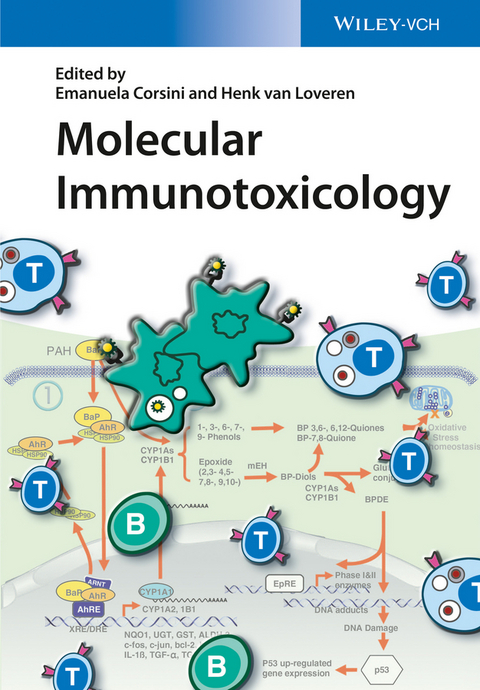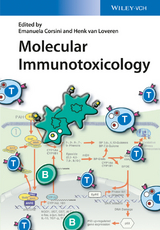Molecular Immunotoxicology
Wiley-VCH (Verlag)
978-3-527-33519-0 (ISBN)
- Titel ist leider vergriffen;
keine Neuauflage - Artikel merken
The human immune system is constantly exposed to chemical contaminants, whether from food, water or air. Some chemicals directly elicit an immune response, while others indirectly activate or deactivate components within the immune system. Thus when tracking or predicting the effect of a chemical on the immune system, many different pathways and modes of action need to be considered. Following an introduction to the various pathways and toxicity mechanisms from a systemic perspective, the main part of this comprehensive reference surveys individual molecular mechanisms of important immunotoxicants, from PAHs to biopharmaceuticals, and from receptor-mediated toxicity to nanoparticle toxicity, using analyses based on molecular effects rather than on animal models.Taken together, the knowledge presented here provides an up-to-date overview of this hot topic that can be directly applied to the prediction and characterization of immunotoxic effects in drugs, chemicals, and environmental contaminants.
Emanuela Corsini is associate professor of Toxicology at the School of Pharmacy of the University of Milan (Italy), where she heads the Laboratory of Immunotoxicology and Immunopharmacology. She obtained her PhD in Food and Environmental Toxicology in 1993 at the University of Milan. Dr. Corsini's research program encompasses distinct areas of immunotoxicology, including the understanding of the molecular mechanisms of action of immunotoxic/immunomodulatory compounds on both innate and adaptive immunity. She is active in numerous scientific and professional organizations, serves on several editorial boards of Toxicology journals. From 2009-2013 she was Member of EUROTOX Education Sub Committee, from 2005-2011 she was the Chair of the Immunotoxicology and Chemical Specialty Section at EUROTOX, and from 2010 she is one of the Director of the IUTOX Executive Committee. Henk van Loveren did his PhD (tumor immunology) at Utrecht University in 1981 and was post-doctoral fellow (immunology) at Yale University, New Haven CT, USA in 1982. Since 1984, he is at the National Institute of Public Health and the Environment in Bilthoven, the Netherlands, where he has run the Immunotoxicology program and is now Senior Scientific Advisor to the Centre of Health Protection. In addition, he is also Professor of Immunotoxicology at Maastricht University in the Netherlands. His research has been devoted to the development of immunotoxicity testing, being performed in cell systems, in laboratory animals and clinical settings. Recent developments are the implementation of toxicogenomics in immunotoxicity testing. He has been member of several advisory committees, in addition to being director of the WHO Collaborating Centre for Immunotoxicology and Allergic Hypersensitivity. Prof. van Loveren was one of the founders of the Immunotoxicology and Chemical Specialty Section at EUROTOX and served as its president from 2000-2003. For his achievements, he got the Vos Career Achievement Award Immunotoxicology of the American Society of Toxicology in 2008, and the Merit Award 2010 of the European Federation of Toxicology Societies.
Preface
THE EVOLUTION OF IMMUNOTOXICOLOGY
Introduction
Immune-Mediated Environmental Lung Diseases
Immunotoxic Drug Reactions
Autoimmunity
Immunosuppression
Allergic Contact Dermatitis (ACD)
Summary
OVERVIEW OF THE MECHANISMS UNDERLYING CHEMICAL-INDUCED IMMUNOTOXICOLOGY
Introduction
Mechanisms of Immunotoxicity
Conclusions
USE OF TOXICOGENOMICS IN IMMUNOTOXICOLOGY
Introduction
Toxicogenomics
Bioinformatics and Data Analysis
Multiple Omic Approaches in the Evaluation of Immunosuppressive Compounds
Summary and Conclusions
BREAKDOWN OF THE MOLECULAR PROCESSES DRIVING THE ADVERSE OUTCOME PATHWAYS (AOPs) OF SKIN AND RESPIRATORY SENSITIZATION INDUCTION IN HUMANS EXPOSED TO XENOBIOTICS AND PROTEINS
Introduction
The AOP for Skin Sensitization
The Molecular Processes in the MOA for Sensitization Induction
Summary
CHEMICAL ALLERGEN-INDUCED SKIN CELL ACTIVATION
Introduction
Breaching in Barriers
Role of the Extracellular Matrix in Skin Inflammation
Cytoprotective Responses and Skin Inflammation
Skin Dendritic Cells - Tolerance versus Immunity
DC Activation and Migration
The Role of Danger Signals
Inappropriate/Compromised DC Activation
T-Cell Activation and Immune Regulation
Allergic Contact Dermatitis as a (Sterile) "Infection" - Implications
THE ARYL HYDROCARBON RECEPTOR (AhR) AS A MEDIATOR OF ADVERSE IMMUNE REACTIONS
Introduction
The Arylhydrocarbon Receptor - a Sensor of Chemicals and a Link to Our Chemical Environment
Immunotoxicity of TCDD, the Paradigm Ligand of AhR
AhR-Deficient Animal Models to Study AhR Function in the Immune System
Concluding Remarks
IMMUNOTOXICOLOGICAL EFFECTS OF PHARMACEUTICALS ON SIGNAL TRANSDUCTION IN INNATE AND ADAPTIVE IMMUNITY
Introduction
Drug Affecting Signal Transduction in Innate Immunity
Drug affecting Signal Transduction in Adaptive Immunity
PROMISES AND CHALLENGES WITH IMMUNOMODULATORY BIOLOGICS
Introduction
Adaptive Immunity in the Control of Tumors
Recent Developments in Oncology Immunotherapy - Case Examples
Conclusions
THE NONCLINICAL EVALUATION OF BIOTECHNOLOGY-DERIVED PHARMACEUTICALS, MOVING ON AFTER THE TEGENERO CASE
The TeGenero (TGN1412) Case
The EU CHMP Risk Mitigation Document
MABEL versus NOAEL Approach
Predictivity of Antibody Properties, Pharmacodynamics, Pharmacokinetics, and Toxicology
New Developments in Biological Testing: In Vitro Approaches?
Cytokine Release Assays
Conclusions
GLUCOCORTICOLD-INDUCED IMMUNOMODULATION
Introduction
Mechanism of Action
GC Resistance
GC Effects on the Immune System
GC, Inflammation, and Immunosuppression
GC and Autoimmunity
Conclusions and Perspectives
PARTICULATE MATTER-INDUCED IMMUNE ACTIVATION
Background and Introduction
The Human Evidence
Do Physical or Chemical Particle Components Mediate Immune Stimulation?
Particle Adjuvant Effect - The Primary and Secondary Response
Particle Properties and Adjuvant Effect - Size is a Critical Factor
Interactions of Particles with the Immune System
Genetic Factors
Mechanisms of Particle Adjuvanicity
Oxidative Stress
Summary and Conclusions
GENOTOXIC MECHANISMS OF PAH-INDUCED IMMUNOTOXICITY
Introduction
General Chemical Structure of PAHs
Aryl Hydrocarbon Receptor (AhR)-Mediated Immunotoxicity Pathways
PAH-Induced Immunotoxicity via AhR-Independent Pathway
Microsomal Epoxide Hydrolase (mEH)
Genotoxic Pathways
PAH-Induced Apoptosis Pathways in T Cells, B Cells, and Macrophages
IMMUNOTOXIC EFFECTS OF PERFLUOROALKYLATED COMPOUNDS: MECHANISMS OF ACTION
Introduction
Immune Effects of PFOA and PFOS in Animal Models
Immune Effects of PFOA and PFOS in Humans
Mechanisms of Action
Conclusions
PESTICIDE-INDUCED IMMUNOTOXICITY: MOLECULAR TARGETS
Introduction
Summary
MODE OF ACTION OF ORGANOTINS IN IMMUNE CELLS
Introduction to Tributyltin Compounds
Findings on Immunotoxicity of TBTs Based on Animal Studies
Differential Effects of TBTs on Prenatal, Postnatal, or Adult Rats
Lactational Transfer of TBT
Effects of Organotin Compounds on the Immune Function of Aquatic Organisms
Modes of Action of TBTO as Assessed by Cytological and Biochemical Assays
Toxicogenomics Studies on the Modes of Action of TBTs
Summary
Index
| Erscheint lt. Verlag | 1.10.2014 |
|---|---|
| Sprache | englisch |
| Maße | 170 x 244 mm |
| Gewicht | 895 g |
| Themenwelt | Studium ► 2. Studienabschnitt (Klinik) ► Pharmakologie / Toxikologie |
| Naturwissenschaften ► Chemie | |
| Schlagworte | Biowissenschaften • Cell & Molecular Biology • Cell & Molecular Biology • Chemie • Chemistry • Ecotoxicology & Pollution Science • Ecotoxicology & Pollution Science • Environmental Studies • Environmental Toxicology • Immuntoxikologie • Life Sciences • Molekularmedizin • Ökotoxikologie, Umweltverschmutzung • Toxicology • Toxikologie • Umweltforschung • Umwelttoxikologie • Zell- u. Molekularbiologie |
| ISBN-10 | 3-527-33519-6 / 3527335196 |
| ISBN-13 | 978-3-527-33519-0 / 9783527335190 |
| Zustand | Neuware |
| Haben Sie eine Frage zum Produkt? |
aus dem Bereich




